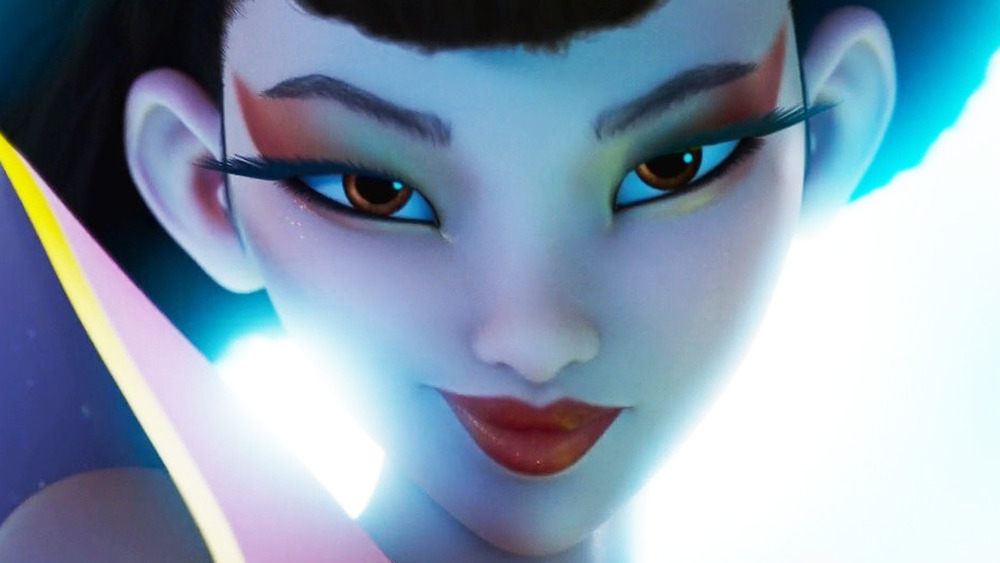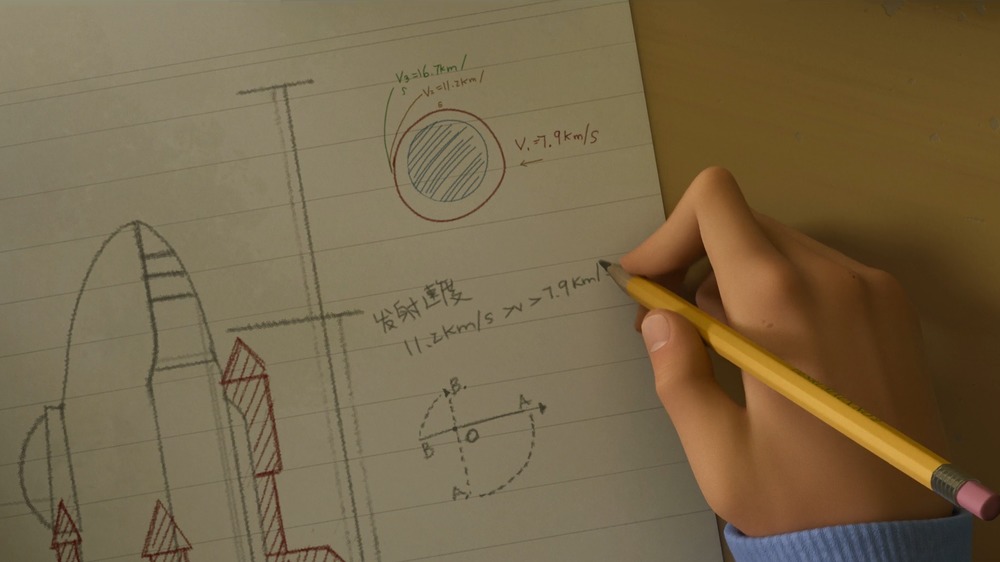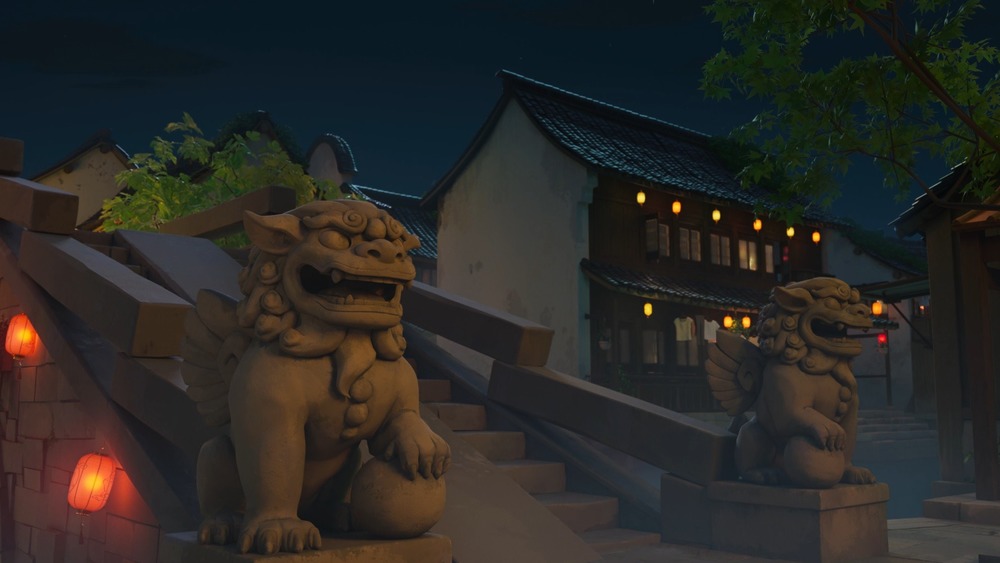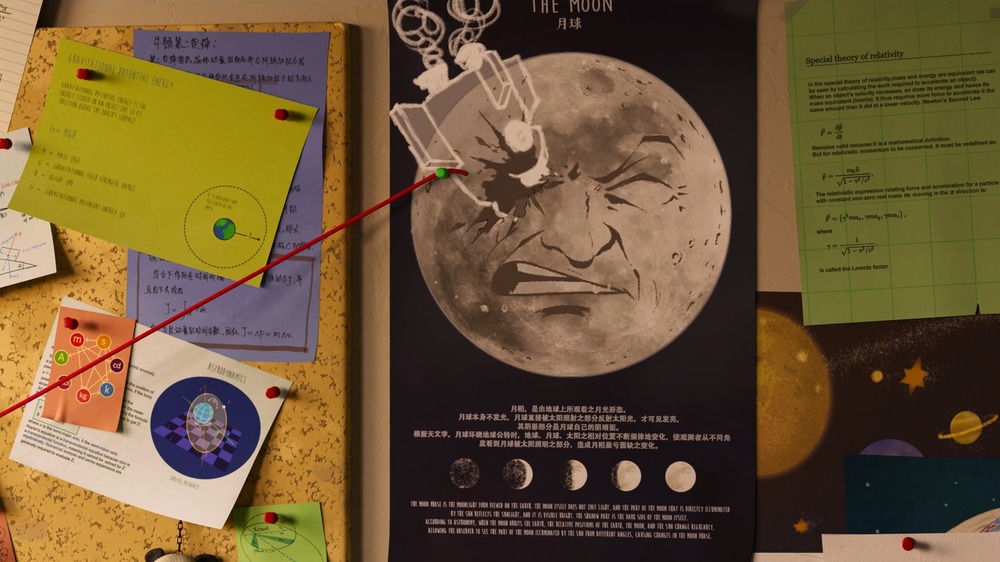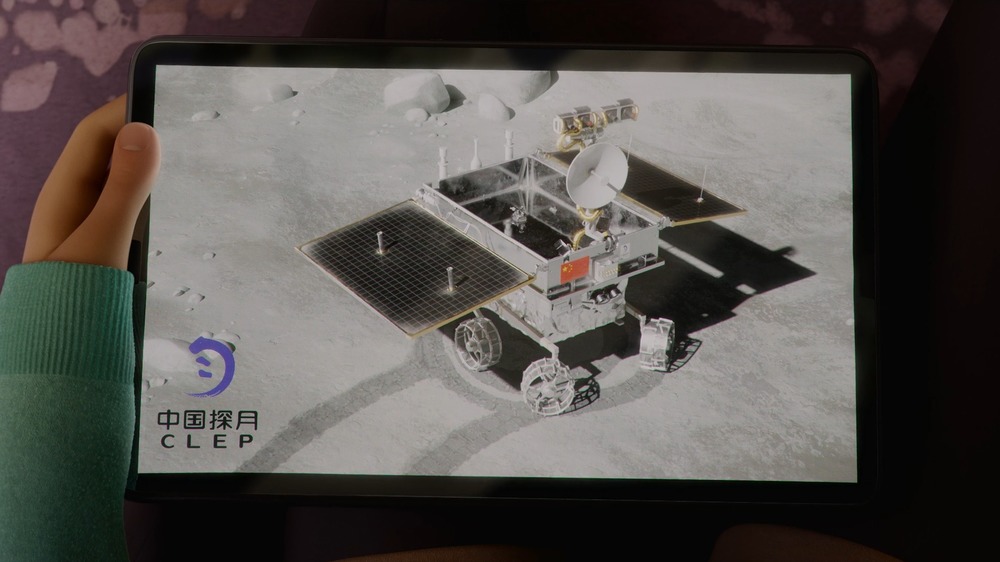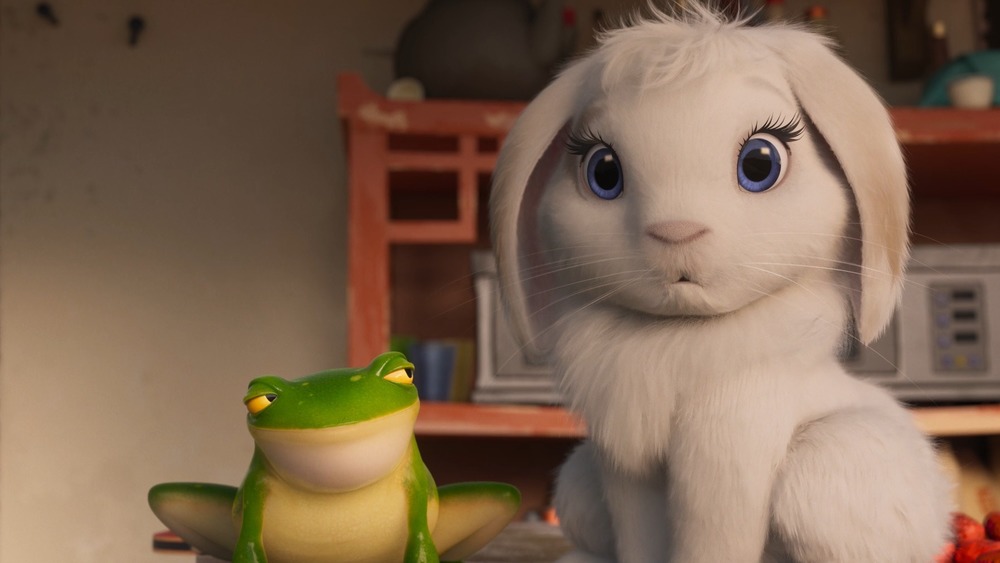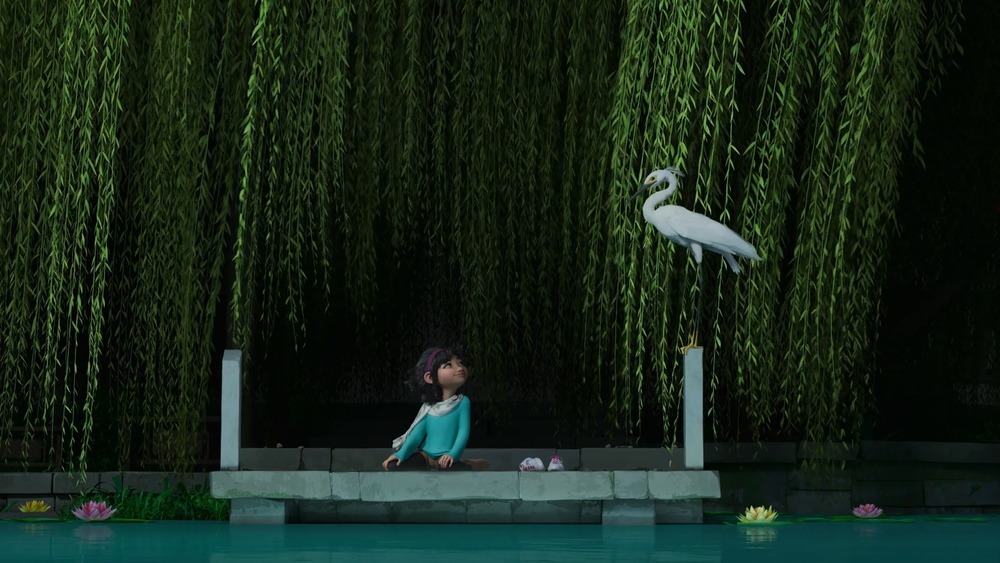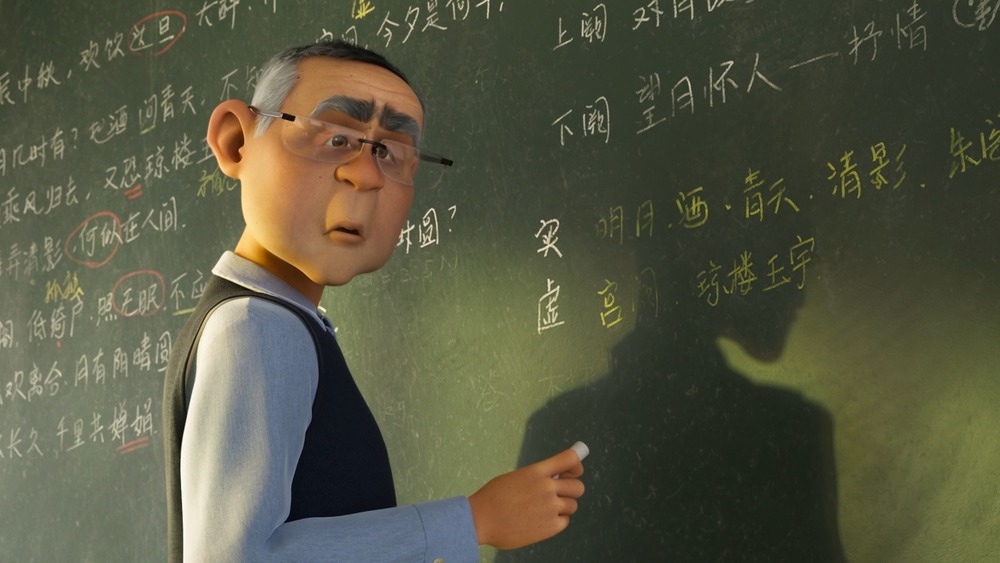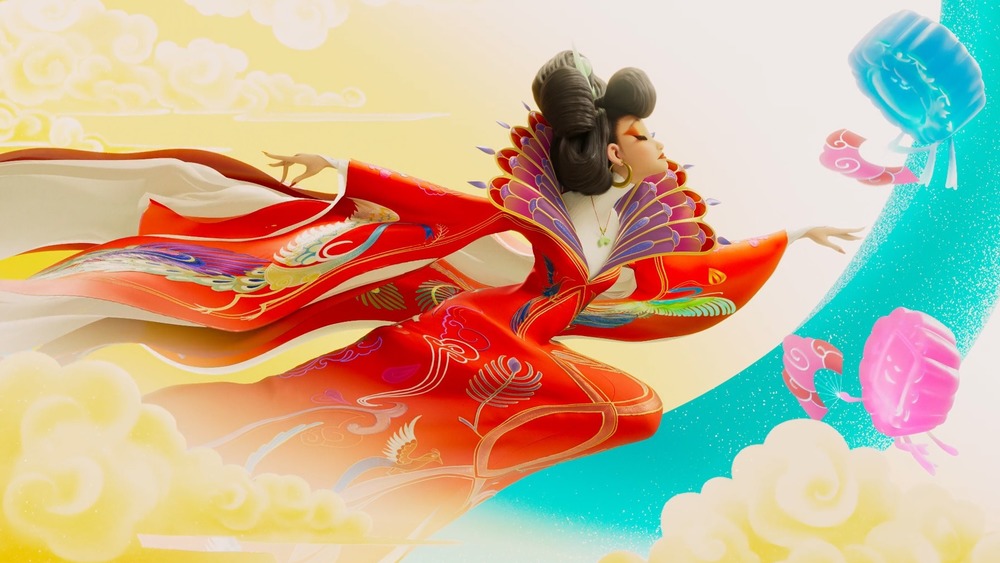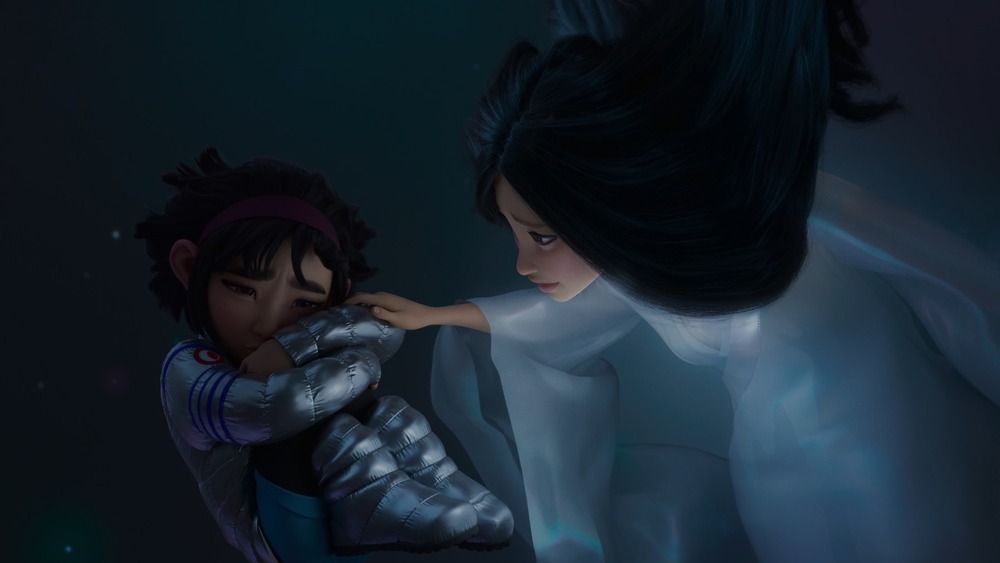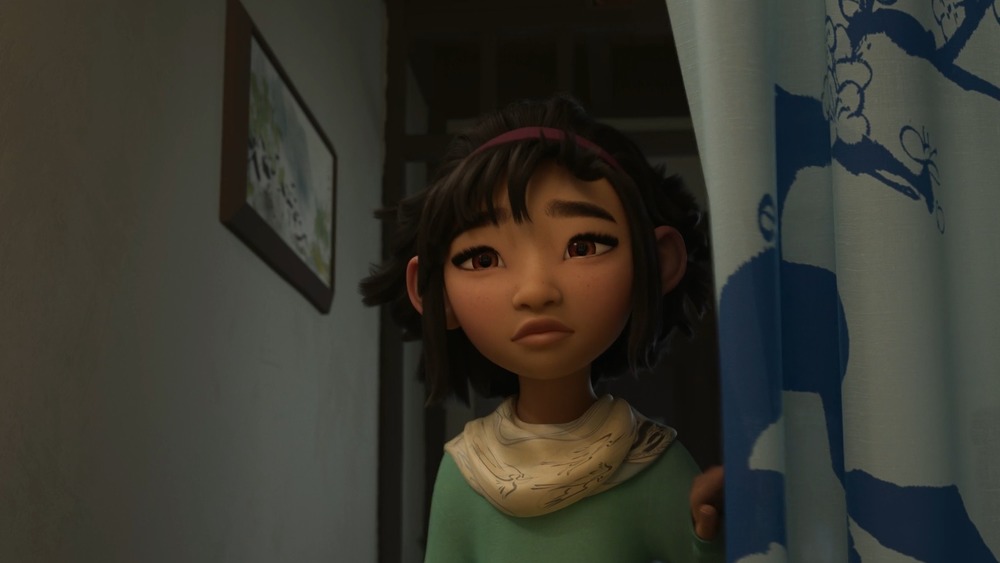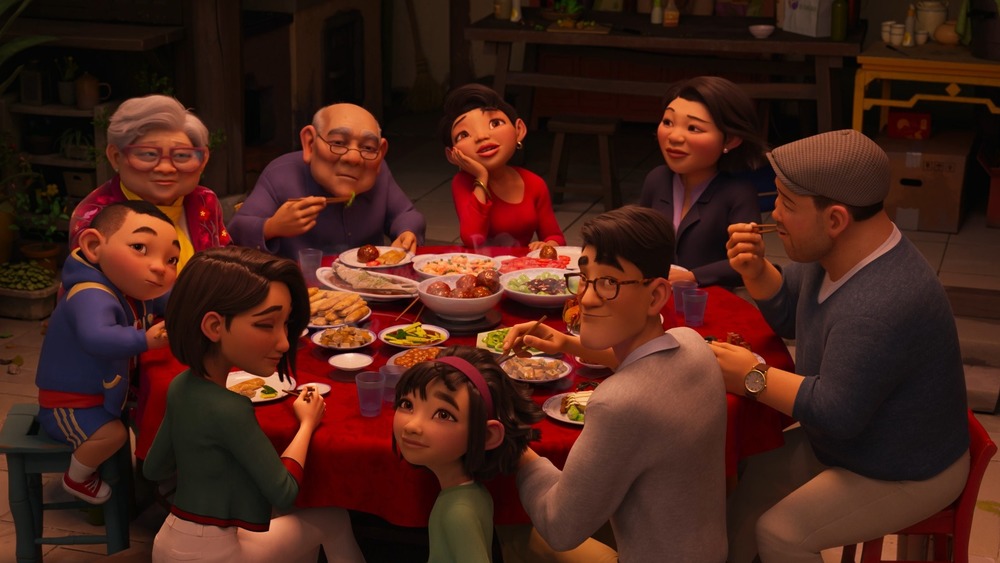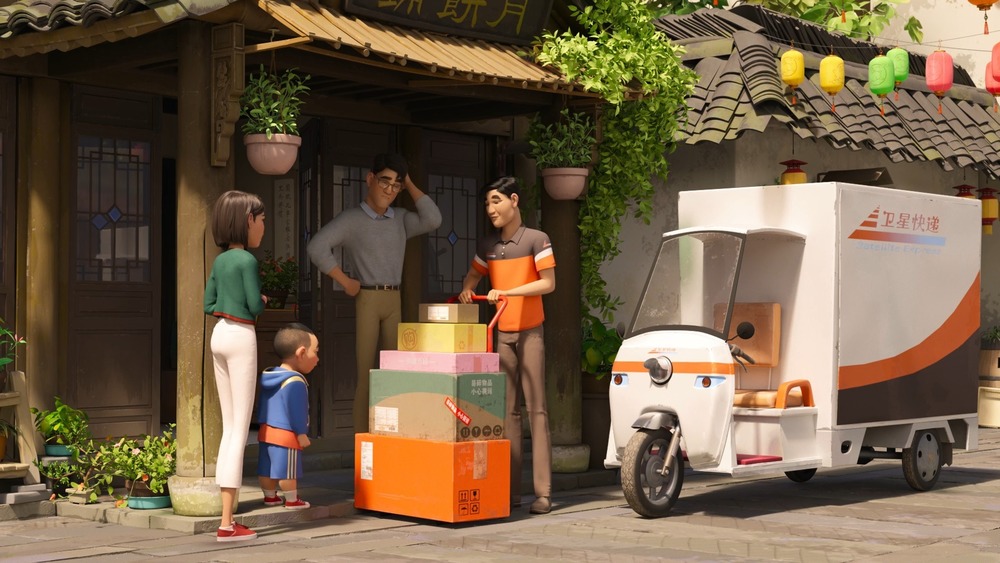Things Only Adults Notice In Over The Moon
Released in theaters and on Netflix on October 23, 2020, Over the Moon tells the story of Fei Fei, a young girl who builds a rocket to take her to the moon. Fei Fei knows that Chang'e, a lonely moon goddess, waits there, longing to be reunited with her human love, Houyi. Apart from wanting to prove Chang'e is real, Fei Fei also wants to convince her dad to wait to be reunited with his own late wife, Fei Fei's mother, instead of remarrying.
Though the film was produced by Pearl Studio, Netflix Animation, Dentsu Entertainment, Sony Pictures Imageworks, and Glen Keane Productions, Over the Moon feels very much like a film in the Disney tradition. This is primarily due to the film's director, Glen Keane, who worked for decades as a Disney animator before seeking out more independent avenues of pursuing his craft.
Though the film is primarily marketed to children, as evidenced by its two animal sidekicks and the brightly colored cast of moon residents, there is still plenty on offer for older viewers. Here is a list of things only adults notice in Over the Moon.
Fei Fei uses real rocket science
An aspect of Fei Fei's character some might find a bit contradictory is that she is at the top of her class, yet still believes in the legend of Chang'e. These seemingly at-odds parts of Fei Fei's personality are enough to get her relatives talking after she storms away from the Moon Festival meal with her grandparents, aunts, uncle, father, his fiancée, and her son, Chin. While some family members find her continued devotion to the moon goddess a bit odd, Fei Fei's scientific and mathematical aptitude is actually the perfect catalyst to fuel her ambitions to fly to the moon in search of myth.
As Fei Fei sings about building a rocket to the moon, a mathematical formula appears on screen in white text. Though some of the characters are in Chinese, viewers of any background can discern the formula's structure and some of the numbers included, which make what Fei Fei has conceptualized plain. Need a hint? The formula in question is used to determine the velocity needed to escape the Earth's gravitational pull and launch into space. According to Vanderbilt University, escape velocity equals the square root of two times the gravitational constant times the mass of the planet divided by the radius. Easy, right?
The stone lions are a same-sex couple
As Fei Fei heads out on her bike to sell mooncakes around town, she undertakes what seems like a small ritual. As she approaches the bridge just outside of her home, she pats one of the stone lions on the head. At the end of the film, both of the lions are shown briefly as Fei Fei carries Chin back home. The audience can then see an interesting design choice on display: Namely, both of the lions have a single paw resting on a stone sphere.
According to Encyclopedia Britannica, the Lion of Fo, or Shishi, is a statuary figure popular in China that has significance as a guardian, often at a Buddhist temple (though they are also featured in other architectural settings). Typically, Shishi are made in pairs, with males having a paw resting on a ball and females with a paw on a cub. Since the Shishi at the foot of the stone bridge outside Fei Fei's house both have their paws resting on balls, that means they are both male. Though this was likely unintentional, it does apparently make this set of Shishi a same-sex pairing.
A poster in Fei Fei's room is a nod to silent film innovation
During the song "Over the Moon (Reprise)," a variety of posters are seen in the background of Fei Fei's room. Though there are many colorful examples of space-related imagery on display, the most interesting directly references a silent film from 1902.
For a brief moment, viewers see a poster featuring a moon with a drawn-on human face, grimacing at the rocket ship that has crashed into its eye. Film historians will recognize this as an homage to A Trip to the Moon (Le Voyage dans la Lune) by French filmmaker and cinematic pioneer George Méliès. As seen in Over the Moon, the moon in A Trip to the Moon has a face that is hit in the eye by a rocket ship, causing it to clench up its features in pain. Aside from this brief visual similarity, both films also center around scientists making a voyage to the moon and stumbling upon a strange and fantastic world.
Though A Trip to the Moon lacks a moon goddess or floating space frogs, the short film is a classic example of formalist filmmaking that is still screened in film classes around the world. Given the similarities in title and story, it's no wonder that the creatives behind Over the Moon saw it fitting to reference Méliès' work.
Chinese spacecraft are indeed named after folkloric figures
Fei Fei, Chin, and most of the rest of the cast of Over the Moon are totally fictional characters. But the same can't exactly be said of Chang'e. In fact, there's a way for fans to see Chang'e in real life — but they'd have to go into space to do so. While there might not be a goddess on the moon living beside her rabbit companion, Chang'e and Jade Rabbit do indeed exist through scientific innovation.
As is seen in the film, China has its own robust space exploration infrastructure, and has successfully launched several satellites and lunar missions in the past. Just like NASA has named missions after Greek gods like Apollo, one Chinese mission is named after the moon goddess, Chang'e. According to Science Magazine, the Chang'e 4 lander successfully touched down on the far side of the moon in 2019, delivering the Yutu-2 (or Jade Rabbit-2) rover to roam the moon's less-explored side. Fei Fei views both of them on her tablet as she conceptualizes her rocket, and also runs into the Yutu-2 near her lunar crash site. In this way, Over the Moon references both the real-world myth of the moon goddess and current Chinese space exploration.
The abundance of moon references
Unsurprisingly for a movie about taking a trip to the moon to meet the moon goddess, Over the Moon features several subtle (and not-so-subtle) references to moon mythology throughout its runtime. In Chinese culture, some see a toad outlined in the dark spots on the lunar surface, while others see a hare using a mortar and pestle. Both are relevant to the story of Chang'e, since some interpretations of her story have her turn into a toad once she gets to the moon to wait for Houyi with the Jade Rabbit. As such, rabbits, hares, toads, and frogs are all associated with the moon in Chinese culture.
In the film, frog and rabbit imagery is everywhere. Fei Fei plays with a rabbit lamp as she enters her parents' shop, where mooncakes are sold in boxes with rabbits on them. Later on, Fei Fei's computer is shown, which has bunnies on each speaker. She also has a small rabbit figure on a shelf and a notepad with a white rabbit's face on the front cover. It seems natural that her parents, who love the Moon Festival, would give her a pet rabbit. And what better counterpart for a rabbit than a frog named Croak to round out the moon-faring group?
It's implied that the crane is Fei Fei's mom
After Fei Fei's mother dies, she sits on the dock where they'd spent so much time together and wonders aloud what she should do to get her dad to postpone his upcoming marriage. She believes that her father should wait to be reunited with his late wife, as in the legend of Chang'e and Houyi. Weighed down by sadness, Fei Fei looks to the moon and sees a crane flying directly into its light. After Fei Fei returns from the moon, she once again encounters the crane on the dock. After sharing a few seconds of eye contact, the crane takes off close to Fei Fei's head, grazing her hair with its wings.
In an interview with Slashfilm, Glen Keane said, "It was ... a very important moment, when I first storyboarded that, Fei Fei was talking to her mom. And then we took all of that dialogue out and it played so much better. And her mother makes our appearance there, in that crane in a sense." Though Keane doesn't outwardly state that Fei Fei's mother is the crane, the crane is present at both the start and conclusion of Fei Fei's emotional journey. Based on the director's testimony, paired with these themes, it is heavily implied that the crane is Fei Fei's mother — or at the very least, closely connected to her spirit.
The classroom poem ties into the film's larger themes
As Fei Fei spends her time in class drawing schematics and jotting down calculations for her impending flight, her teacher can be heard in the background giving a lesson. Even though Fei Fei isn't paying that much attention, attentive listeners may hear her teacher say that the subject they are studying is "the most famous poets in the Tang and Song dynasties."
Culturally savvy viewers will recognize the characters on the blackboard as belonging to the Song dynasty poet Su Shi. The poem being presented is "Prelude to Water Melody," which is about Su Shi's longing to see his brother, from whom he's been separated for several years. The song is emblematic of the Mid-Autumn Festival (or Moon Festival), as it is an opportunity for families to reunite and eat together around a shared table. The Moon Festival happens to be the favorite holiday of Fei Fei's mother, and the holiday that many families eat mooncakes on, making it especially important to Fei Fei's whole family. So while Fei Fei might not be paying much mind to the lessons taught in school, adult viewers will want to listen in on the lecture or miss out on yet another tie to the Moon Festival, and the theme of grief that permeates Over the Moon.
The famous name behind Chang'e's outfits
Chang'e's wardrobe is just as memorable as her larger-than-life personality. From her sparkly pop star outfit to her sporty get-up to the intricate and traditional dress she wears when she sees Houyi, it's evident that a lot of attention went into every detail of the moon goddess' attire. When the credits finally roll, fashion-savvy adults will recognize the name behind Chang'e's well-crafted and stylish wardrobe, and understand immediately why she looks so good.
The film's costume designer is Guo Pei, a famous Chinese fashion designer who gained major international buzz after designing Rihanna's dress for the 2015 Met Gala. In an interview with Variety, Guo Pei talked about her inspirations for Chang'e's vast wardrobe: "The patterns come from the precious ancient Shu collections in the [Sanxingdui] Museum, including the Han brocade discovered in Mawangdui and the bronzeware discovered in Sanxingdui." When depicting a goddess whose origin is more than 1,000 years old, historical examples of royal garments really are the best way to go.
Chang'e's more modern looks are also imbued with meaning. Regarding her pop star outfit, Pei noted, "The idea is that the fabric of the costume is certainly not of the earth — it might be a special energy or texture from the moon — and the fabric would flow and change like moonlight according to Chang'e's movements."
Learning to move on with grief
Throughout the film, both Fei Fei and her father try to deal with their grief. Longing for a lost love or source of happiness is, in fact, a constant throughout the film. In Fei Fei's classroom, her teacher discusses a poem about the author's longing for his brother from whom he's been separated for years. Fei Fei decides to travel to the moon to prove to her dad that Chang'e exists, and that she eternally waits for her lover, Houyi. Gobi, one of the moon residents, has been exiled from Chang'e and desperately wants to go back.
However, while all these characters grieve for some sort of loss, Chang'e and Fei Fei manage to figure out how to move forward with their grief together in the Chamber of Exquisite Sadness. Keane spoke to Slashfilm about the film's themes, saying, "We go forward in life and the pain that we experience becomes part of us, becomes part of our beauty. And it was a very important moment that the reason that the crane flies over her is so that the wings can touch Fei Fei's hair, as if to say, 'You're beautiful. You're wonderful,' like the song that Gobi sings." In accepting her pain, Fei Fei is able to find happiness and love in her newfound family, demonstrating a lesson many adults have learned well.
Fei Fei's hair is an integral part of her character development
As a character designer and animator for Disney, Glen Keane always paid close attention to his characters' hair. Keane expounded upon this practice in an interview with Movie Mom, highlighting a few key characters: "For Rapunzel, her hair was irrepressible, uncontainable. For Pocahontas, it showed the spirit moving in her. For Ariel, the hair always looked like it was floating in the water."
Fei Fei's hair is just as crucial, according to Keane. At the beginning of the film, her long hair is shown being combed by her mother as she tells her about Chang'e and the space dog creating the cycles of the moon. Later, Fei Fei externalizes her grief by cutting her hair. As Keane explains it, her hair serves as a visual metaphor for her turbulent emotional landscape: "Her chopped off hair is a constant reminder of that chaos in her life. That design choice dictated so much, too." Her hair is so emblematic of her character that the first thing Chang'e says to Fei Fei is, "What butcher cut your hair?" After telling her that her face shape would be complemented by long hair, she then officially welcomes "Unfortunate Hair Girl." Fei Fei is literally marked by the trauma of losing her mother and her inability to make things the way they once were.
The importance of the all-Asian cast
Considering its roots in Chinese culture, it's only natural that Over The Moon's cast and crew was filled with people of Asian descent. This wasn't an accident. According to Peilin Chou, one of the producers of Over the Moon, this cast make-up was essential to her, as a Taiwanese immigrant, and to other members of the film's creative team.
In an interview with NBC, Chou explained that many cultural norms and familial dynamics seen in the movie, such as Fei Fei's grandmother asking if she has eaten enough, are crucially important, but "not really something you can research." They're intimately understood and recognized, however, by many Asian people. As Chou noted, "It's not the same if you're a white person from Cleveland, Ohio, and you are supposed to play a Chinese moon goddess. I don't know how you connect with that in anywhere near the same way."
Chou also spoke about the film's voice talent and how they related to their characters, saying," Philippa Soo, who is half Chinese and plays Chang'e, she talks a lot about, for example, when she embodies the role, how much it was influenced by growing up knowing the myth ... Culturally, growing up in that kind of family just really informed what she brought to the role."
Fei Fei's rocket costs her family a lot of money
Once Fei Fei decides that she will go to the moon to prove that Chang'e exists, she realizes that she will need to build and design her own rocket to get the job done. Knowing that space travel is an incredibly intricate and precise affair, Fei Fei goes to the internet to gather supplies that she can use to make a few un-crewed test flights. After asking for her father's permission, she purchases her supplies without a hitch. Unfortunately for her father, Fei Fei purchases a staggering 132 items online, including magnets, fireworks, and electronics. Even for an academically advanced student like Fei Fei, that seems like a lot of supplies to buy for a science project.
While it doesn't seem like Fei Fei's family is suffering financially, a purchase of 132 science-related items appears to be a substantial financial burden for her single-income household. Moreover, It's obvious that Fei Fei's purchases catch her father off-guard, and that he didn't expect his daughter's science project to necessitate so many orders. Even if Fei Fei didn't break the bank, she likely left an unexpected dent and a lot of anxiety. Seriously, every adult viewer feels a chill go down their spine at the phrase "132 items purchased."
